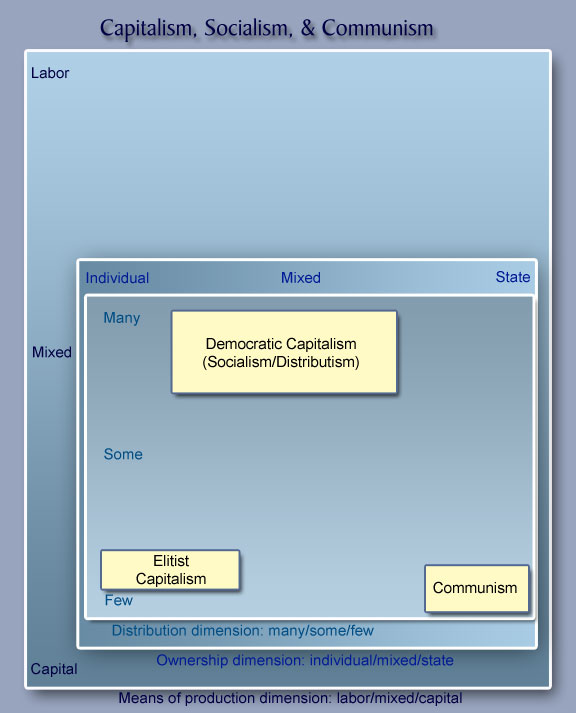Legend for Capitalism, Socialism, & Communism Diagrammed
Diagramming the essential features of these three economic systems requires three dimensions of analysis:
the means of production, ownership, and distribution.
The Means of Production:
Is production of economic goods accomplished primarily via labor or via
capital?
Ownership:
Is ownership of the means of production relegated to the state or to the individual?
Distribution:
Is ownership of the
means of production narrow (in the hands of a few), or broad (in the hands of many)?
If economic production is accomplished primarily via capital, we have a capitalistic economy (which, surprisingly to many, may be capitalistic in the corporate sense, socialistic, or communistic). If via labor, the economy is “laboristic” (and may also be corporate capitalistic, socialistic, or communistic) .
If ownership of the means of production is relegated to the state we have Communism. If relegated to
individuals, we have economic individualism.
If distribution of ownership is narrow (the means of production are owned and controlled by only a wealthy few individuals), we have economic
elitism. If distribution of ownership is broad (the means of production are owned and controlled by many individuals), we have economic democracy (or, more commonly, socialism, which has sometimes also
been called “distributism”).
Traditional economic liberalism is represented by mixed ownership of the means of production and, much more weakly, distribution of ownership of the means of production among many. However, genuine economic liberalism would reverse this emphasis, so that broad ownership of the means of production would be a primary objective.
Traditional economic conservatism is represented by
individual ownership/distribution among many; but contemporary conservatism (pseudoconservatism) actually signifies individual ownership with distribution limited to a (hyperwealthy) few.
Contemporary pseudoconservatism in the US exhibits strong trends toward both theocracy and facism, in a form of authoritarian rule in which state authority and economic control are merged under one leader with consolidated control of both. (Leaders of this kind may claim to rule in the name of God, yet constantly emphasize militaristic and "patriotic" themes so as to obtain a maximum of personal power).
A less democratic orientation, and one more completely destructive of individual freedoms, can hardly be imagined.
To view the essay accompanying this diagram, see "Comparison: Capitalism, Socialism, & Communism".
To view a related diagram, which clarifies the political spectrum, see "The True Political Spectrum".

